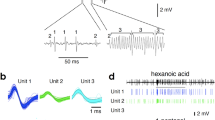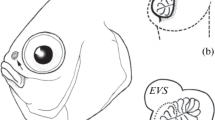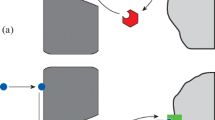Summary
-
1.
Responses of single pore plate olfactory cells on the antenna of Dytiscus marginalis to odour substances in either air or water were determined by means of extracellular recordings.
-
2.
In air the stimulus was applied by a syringe olfactometer. Under water it was applied by a turbulence-free water jet. The number of molecules arriving per time and area at the stimulus site (odour stream density) was determined by gaschromatography and radiometry methods with an accuracy of 25% in air and 15% in water.
-
3.
The olfactory cells responded either to oxygenic (class 1) or to nitrogenic (class 2) compounds.
-
4.
The pore plate was found to be the “olfactory organ” which was used in air as well as under water.
-
5.
Identical stimuli give the same response in air and under water.
-
6.
The response does not depend on the physico-chemical state of the stimulus molecules (dissociation) in their carrier (air or water).
-
7.
From 5. and 6. and according to measurements of the stimulus particle adsorption on the antenna surface it is assumed that the sensilla surface has a special structure (hydrophilic-lipophilic phase boundary).
-
8.
Olfactory perception therefore depends only upon the properties of the receptor cells, the carrier merely transports odour particles to the sense cells. One would therefore expect that all olfactory receptors of insects investigated to date should be able to sense olfactorally in any medium not destructive to cell functions.
Zusammenfassung
-
1.
Die Reaktionen einzelner Riechzellen in den Porenplatten auf der Antenne von Dytiscus marginalis L. auf Duftstoffe wurden in Luft und Wasser in extrazellulären Ableitungen qualitativ und quantitativ bestimmt.
-
2.
Die Reizung erfolgte in Luft mit dem Spritzenolfaktometer, in Wasser in einem Strömungskanal. Die pro Zeit- und Flächeneinheit am Reizort vorhandene Molekülzahl (Duftstromdichte c·v) wurde mit gaschromatographischen und radiometrischen Methoden in Luft auf 25%, in Wasser auf 15% genau bestimmt.
-
3.
Die Sinneszellen reagieren entweder auf Sauerstoff organische (1. Klasse) oder auf stickstofforganische (2. Klasse) Verbindungen.
-
4.
Die Porenplatte ist das „Geruchsorgan“ sowohl für Luft als auch für Wasser.
-
5.
Gleiche Reize rufen in Luft und in Wasser gleich große Antworten hervor.
-
6.
Die Reaktion ist unabhängig vom physikochemischen Zustand (Dissoziation) der Reizmoleküle in der Trägerphase (Luft oder Wasser).
-
7.
Aus 5. und 6. und Messungen der Adsorption von Reizpartikeln an der Antennenoberfläche wird auf einen speziellen Aufbau der Sensillenoberfläche geschlossen (hydrophile-lipophile Grenzphase).
-
8.
Die Geruchswahrnehmung hängt daher nur von Eigenschaften der Rezeptorzellen ab. Von der Trägerphase hängt nur ab, wieviel Moleküle zu den Sinneszellen gelangen können. Es ist daher zu erwarten, daß alle bisher untersuchten Geruchsrezeptoren der Insekten in jedem beliebigen, die Zellfunktion nicht schädigenden Medium „riechen“ können.
Similar content being viewed by others
Literatur
Boeckh, J.: Elektrophysiologische Untersuchungen an einzelnen Geruchsrezeptoren auf den Antennen des Totengräbers (Necrophorus, Coleoptera). Z. vergl. Physiol. 46, 212–248 (1962).
Eggert, J.: Lehrbuch der physikalischen Chemie, 8. Aufl. Stuttgart: S. Hirzel 1960.
Gillary, H. L.: Salt receptor of the Blowfly Neurosciences Research Program Bulletin 8, 516–518 (1970).
Haseloff, K., Hoffmann, J.: Kleines Lehrbuch der Statistik, 2. Aufl. Berlin: Walter de Gruyter & Co. 1965.
Hodgson, E. S.: Reaction thresholds of an aquatic beetle, Laccophilus maculosus, to salts and alcohols. Physiol. Zool. 24, 131–140 (1951).
— A study of chemoreception in aqueous and gas phases. Biol. Bull. 105, 115–127 (1953).
Ivanov, V. P.: Ultrastructural organisation of chemoreceptive antennal sensilles of the beetle Acilius sulcatus. J. of Evolutionary Biochemistry and Physiology 2, 461–472 (1966).
- The ultrastructure of chemoreceptors in insects. Arbeiten der gesamten sowjetischen entomologischen Gesellschaft, Bd. 53: Gegenwärtige Probleme der Struktur und Funktion des Nervensystems der Insekten (1969).
Kafka, W. A.: Molekulare Wechselwirkungen bei der Erregung einzelner Riechzellen. Z. vergl. Physiol. 70, 105–143 (1970).
Kaissling, K.-E.: Chemoreception Art.: Insect olfaction. In: Handbook of sensory physiology, Bd. IV. Berlin-Heidelberg-New York: Springer (in press).
—, Priesner, E.: Die Riechschwelle des Seidenspinners. Naturwissenschaften 1, 23–28 (1970).
Korschelt, E.: Bearbeitung einheimischer Tiere. Erste Monographie: Der Gelbrand D. marginalis L., vol. 1, u. 2. Leipzig: W. Engelmann 1923.
Marmont, G.: Studies on the axon membrane. J. cell. comp. Physiol. 34, 351–382 (1959).
Mathes, E.: Das Geruchsvermögen von Triton beim Aufenthalt unter Wasser. Z. vergl. Physiol., 1, 57–83 (1924).
— Der Einfluß des Mediumwechsels auf das Geruchsvermögen von Triton. Z. vergl. Physiol., 5, 83–166 (1927).
Morita, H., Doira, S., Kuwabara, M., Takeda, K.: Electrical response of contact chemoreceptor on tarsus of the butterfly, Vanessa indica. Mem. Fac. Sci., Kyushu Univ. 2, (1957).
—, Shiraishi, A.: Stimulation of the labellar sugar rezeptor of the fleshfly by mono- and disaccharides. J. gen. Physiol. 52, 559–583 (1968).
Netter, H.: Theoretische Biochemie. Berlin-Göttingen-Heidelberg: Springer 1959.
Richter, H.: Wahrscheinlichkeitstheorie, 2. Aufl. Berlin-Heidelberg-New York: Springer 1966.
Schaller, A.: Sinnesphysiologische und psychologische Untersuchungen an Wasserkäfern und Fischen. Z. vergl. Physiol. 4, 370–464 (1926).
Steinhardt, R. A.: Cation and anion receptors in the blowfly, Phormia. In: Hodgson, E. S., Taste receptors of arthropods. Symp. zool. Soc. Lond. 23, 269–277 (1968).
Tinbergen, N.: Eenvoudige proeven over de zintuigfuncties van larve en imago van de geelgerande watertor. Levende Natuur 41, 225–236 (1936).
Vareschi, E.: Duftunterscheidung bei der Honigbiene — Einzelzell- und Verhaltensreaktion. Z. vergl. Physiol, (in press).
Weast, R. C. (ed.): Handbook of chemistry and physics, 46th edit. Cleveland, Ohio: The Chemical Rubber Co. 1965–1966.
Author information
Authors and Affiliations
Additional information
Herrn Prof. Dr. Schneider, der diese Arbeit angeregt hat, und meinen Kollegen, besonders Herrn Dr. Kafka, danke ich für viele wertvolle Diskussionen.
Dissertation der Fakultät für Biologie der Universität München.
Rights and permissions
About this article
Cite this article
Behrend, K. Riechen in Wasser und in Luft bei Dytiscus marginalis L.. Z. vergl. Physiologie 75, 108–122 (1971). https://doi.org/10.1007/BF00335141
Received:
Issue Date:
DOI: https://doi.org/10.1007/BF00335141




